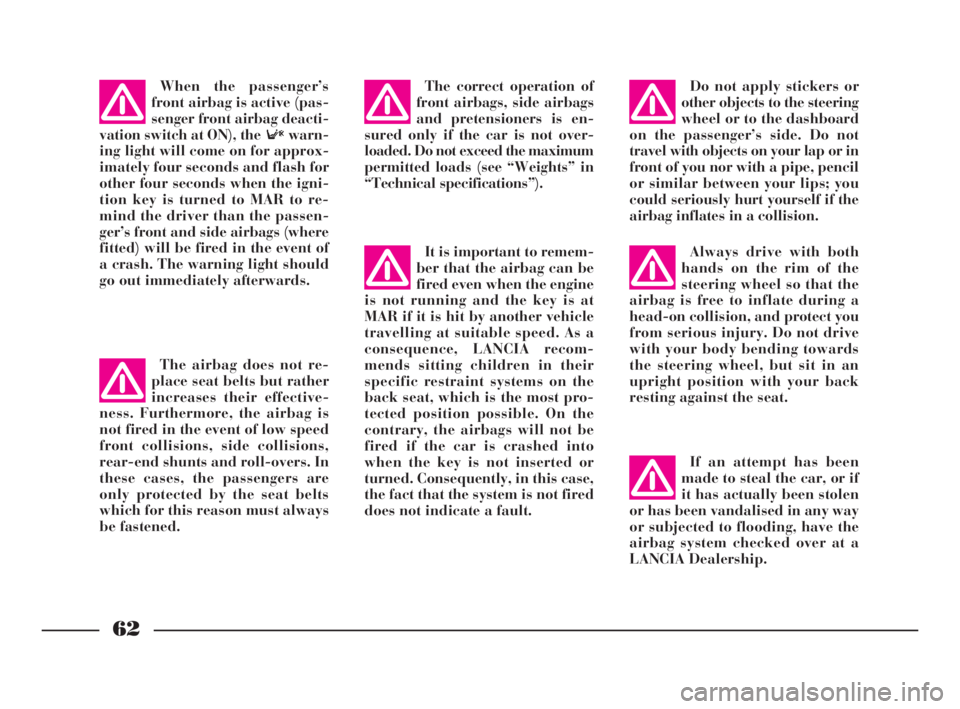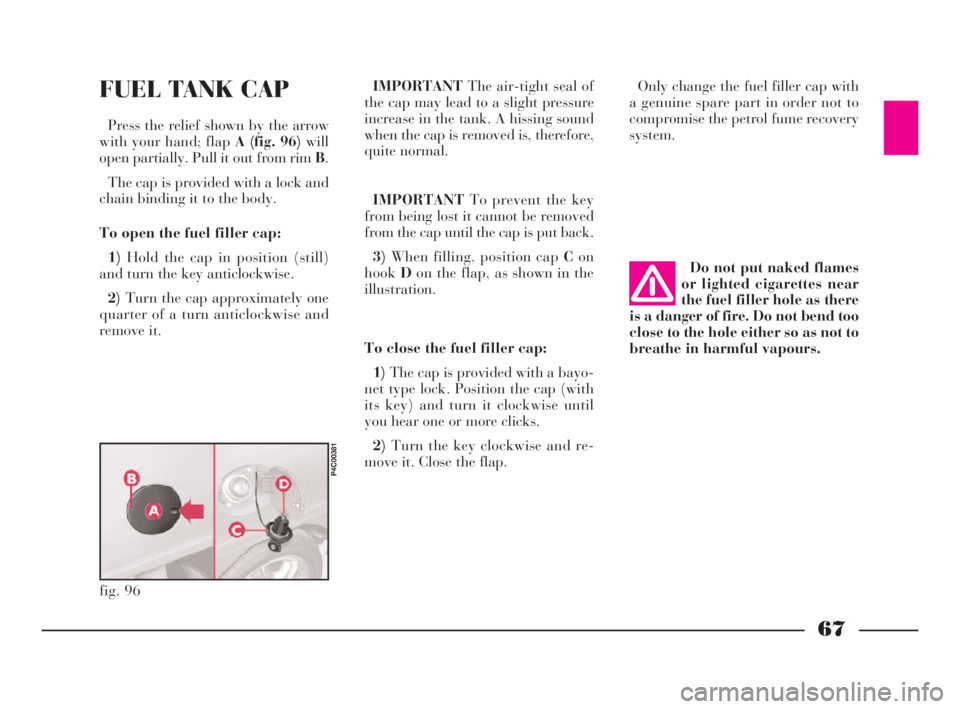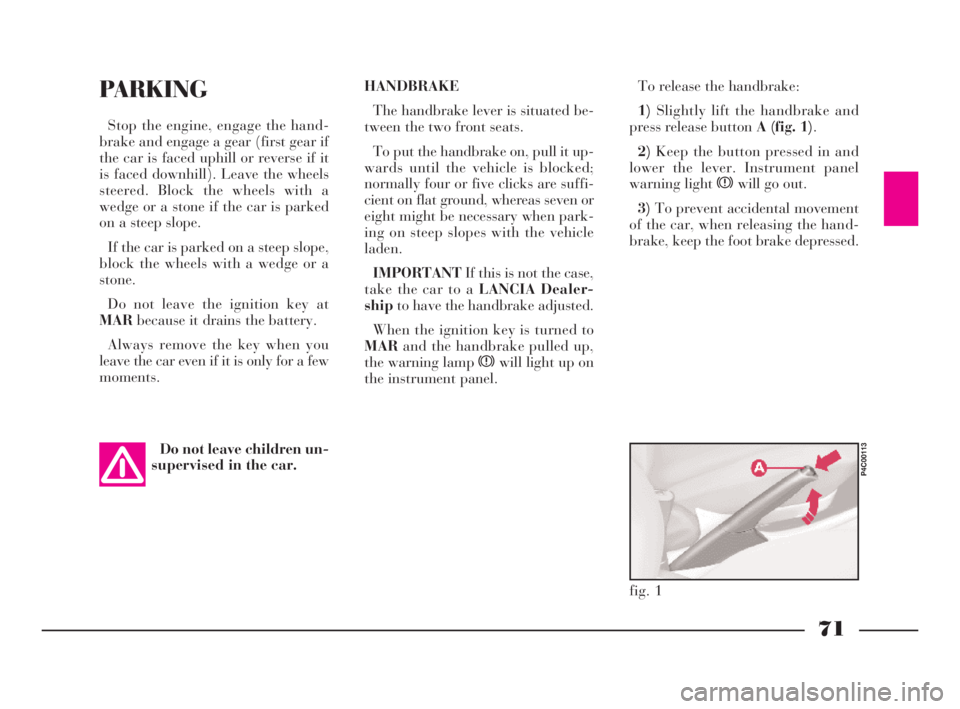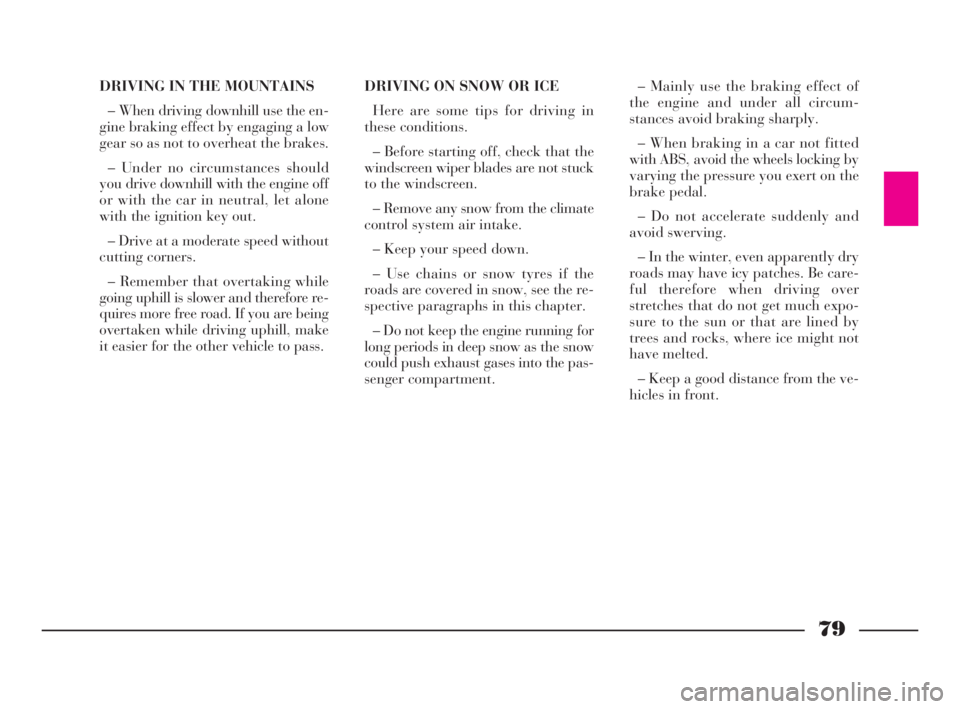key Lancia Ypsilon 2003 Owner handbook (in English)
[x] Cancel search | Manufacturer: LANCIA, Model Year: 2003, Model line: Ypsilon, Model: Lancia Ypsilon 2003Pages: 191, PDF Size: 2.45 MB
Page 64 of 191

61
G
GENERAL WARNINGS
The front and/or side airbags
(where fitted) can be triggered if
the car is subjected to consider-
able crashes or involved in an ac-
cident concerning the underbody
areas, such as a violent impact
against steps, kerbs or projecting
objects fastened to the ground,
falling into large holes or dips in
the road surface.
When the airbag is fired it emits
heat and a small amount of pow-
der. This is not harmful and does
not indicate the beginning of a fire.
Furthermore, the surface of the in-
flated bag and in the passenger
compartment may be covered with
a powdery residues. This powder
may irritate skin and eyes. In the
event of exposure, wash with mild
soap and water.
Go to a LANCIA Dealership as
soon as possible if the warning
light
ûcomes on when travelling
(to signal a fault) to have the prob-
lem repaired. The airbag system is guaranteed
for ten years. Contact a LANCIA
Dealership as the expiry data ap-
proaches.
After an accident which triggered
the airbags, go to a LANCIA Deal-
ership to have the entire safety sys-
tem, the electronic control unit, the
seat belts and the pretensioners re-
placed. The Dealership will also
check the intactness of the electri-
cal system.
Any diagnostic, repair or re-
placement operations concerning
the airbag system must exclusively
be carried out at a LANCIA Deal-
ership.
If you are having the car
scrapped, have the airbag system
deactivated at a LANCIA Dealer-
ship first.
If the car changes hands, the new
owner must be made aware of the
indications given above and be
given this Owner Handbook.The pretensioners (if electroni-
cally controlled), front airbags and
side airbags are activated by the
electronic control unit according
to the type of impact. Conse-
quently, missed activation of one
or more system components does
not indicate a fault in the system.
The instrument panel
warning light ûshould
come on when the ignition
key is turned to MAR and go out
after approximately four seconds.
Immediately contact a LANCIA
Dealership if the warning light ei-
ther does not come on or stays on
or comes on when travelling.
4C001-067 ING 11-03-2008 11:57 Pagina 61
Page 65 of 191

62
G
It is important to remem-
ber that the airbag can be
fired even when the engine
is not running and the key is at
MAR if it is hit by another vehicle
travelling at suitable speed. As a
consequence, LANCIA recom-
mends sitting children in their
specific restraint systems on the
back seat, which is the most pro-
tected position possible. On the
contrary, the airbags will not be
fired if the car is crashed into
when the key is not inserted or
turned. Consequently, in this case,
the fact that the system is not fired
does not indicate a fault.Always drive with both
hands on the rim of the
steering wheel so that the
airbag is free to inflate during a
head-on collision, and protect you
from serious injury. Do not drive
with your body bending towards
the steering wheel, but sit in an
upright position with your back
resting against the seat.
If an attempt has been
made to steal the car, or if
it has actually been stolen
or has been vandalised in any way
or subjected to flooding, have the
airbag system checked over at a
LANCIA Dealership. Do not apply stickers or
other objects to the steering
wheel or to the dashboard
on the passenger’s side. Do not
travel with objects on your lap or in
front of you nor with a pipe, pencil
or similar between your lips; you
could seriously hurt yourself if the
airbag inflates in a collision.
The correct operation of
front airbags, side airbags
and pretensioners is en-
sured only if the car is not over-
loaded. Do not exceed the maximum
permitted loads (see “Weights” in
“Technical specifications”).When the passenger’s
front airbag is active (pas-
senger front airbag deacti-
vation switch at ON), the warn-
ing light will come on for approx-
imately four seconds and flash for
other four seconds when the igni-
tion key is turned to MAR to re-
mind the driver than the passen-
ger’s front and side airbags (where
fitted) will be fired in the event of
a crash. The warning light should
go out immediately afterwards.
The airbag does not re-
place seat belts but rather
increases their effective-
ness. Furthermore, the airbag is
not fired in the event of low speed
front collisions, side collisions,
rear-end shunts and roll-overs. In
these cases, the passengers are
only protected by the seat belts
which for this reason must always
be fastened.
4C001-067 ING 11-03-2008 11:57 Pagina 62
Page 66 of 191

63
G
Do not cover the seat
backs in cars with side
bags.The airbag does not re-
place seat belts but rather
increases their effective-
ness. Furthermore, the airbag is
not fired in the event of low speed
front collisions, side collisions,
rear-end shunts and roll-overs. In
these cases, the passengers are
only protected by the seat belts
which for this reason must always
be fastened.
Do not wash the seat
back in cars with side
airbags with pressurised
steam or water in automatic seat
washing stations.
EOBD SYSTEM
The EOBD (European On Board Di-
agnosis) system fitted in this car com-
plies with Directive 98/69/CE (EURO
3).
This system continuously monitors
the vehicle emission system compo-
nents. Furthermore, the system warns
the driver of deterioration concerning
the emission system components by
means of the warning light on the
instrument panel.
The objective is to:
– monitor system efficiency;
– warn when failures can increase
emissions over the threshold estab-
lished by the European regulations;
– warn of the need to replace deteri-
orated components.
Furthermore, the system is equipped
with a connector for interfacing with
specific tools used to read the error
codes stored in the control unit mem-
ory along with a set of diagnostic and
engine specific parameters.
IMPORTANTAfter eliminating the
problem, your LANCIA Dealership
will run a bench test to fully check the
system. In some cases, a long road test
may be required.Contact a LANCIA Deal-
ership as soon as possible
if the warning light ei-
ther does not come on when the
key is turned to MAR or comes on,
with fixed or flashing light, when
travelling.
4C001-067 ING 11-03-2008 11:57 Pagina 63
Page 70 of 191

67
G
Only change the fuel filler cap with
a genuine spare part in order not to
compromise the petrol fume recovery
system.FUEL TANK CAP
Press the relief shown by the arrow
with your hand; flapA (fig. 96)will
open partially. Pull it out from rim B.
The cap is provided with a lock and
chain binding it to the body.
To open the fuel filler cap:
1)Hold the cap in position (still)
and turn the key anticlockwise.
2)Turn the cap approximately one
quarter of a turn anticlockwise and
remove it.IMPORTANTThe air-tight seal of
the cap may lead to a slight pressure
increase in the tank. A hissing sound
when the cap is removed is, therefore,
quite normal.
IMPORTANTTo prevent the key
from being lost it cannot be removed
from the cap until the cap is put back.
3)When filling, position cap Con
hookDon the flap, as shown in the
illustration.
To close the fuel filler cap:
1)The cap is provided with a bayo-
net type lock. Position the cap (with
its key) and turn it clockwise until
you hear one or more clicks.
2)Turn the key clockwise and re-
move it. Close the flap.Do not put naked flames
or lighted cigarettes near
the fuel filler hole as there
is a danger of fire. Do not bend too
close to the hole either so as not to
breathe in harmful vapours.
fig. 96
P4C00381
4C001-067 ING 11-03-2008 11:57 Pagina 67
Page 72 of 191

69
G
STARTING
THE ENGINEIf the engine does not start at the
first attempt, return the ignition key
toSTOPbefore trying to start the en-
gine again.
If warning light ¢remains lit to-
gether with the warning light
when the ignition key is at MAR,
turn the key to STOPand then to
MAR; if the warning light still re-
mains lit, try with the other keys pro-
vided with the car.
If you are still unable to start the en-
gine, follow the emergency startup
procedure (see “Emergency startup”
in the section “In an emergency”) and
go to the nearest LANCIA Dealer-
shipimmediately.
IMPORTANTDo not leave the ig-
nition key at MARwhen the engine is
off.
The ignition switch fits a safety de-
vice. If the engine does not start at the
first attempt, return the ignition key
toSTOPbefore trying to start the en-
gine again.
In a similar way, you will not be able
to turn the key from MARtoAVV
when the engine is running.It is dangerous to let the
engine run in a garage or
other closed area. The en-
gine consumes oxygen and gives
off carbon dioxide, carbon monox-
ide and other poisonous fumes.
Do not touch the high
voltage cables (spark plug
cables) when the engine is
running.
During the running-in
period do not push the car
up to its highest perfor-
mance (e.g. sudden accelerations,
very long drives at high speed,
sharp braking etc.)
PROCEDURE
IMPORTANTDo not press on the
accelerator before the engine is run-
ning.
1)Make sure the handbrake is up.
2)Put the gear lever into neutral.
3)Press the clutch pedal down to the
floor.
4)Turn the ignition key to AVVand
let it go the moment the engine starts.
4C068-089 ING 11-03-2008 11:59 Pagina 69
Page 73 of 191

70
G
HOW TO WARM UP
THE ENGINE AFTER
IT HAS JUST STARTED
– Begin to move forward slowly let-
ting the engine turn over at medium
revs. Do not accelerate abruptly.
– Do not push the engine to its limit
for the first few kilometres. You are
recommended to wait until the water
temperature has reached 50°C to
60°C (pointer moves slightly from its
initial position).
EMERGENCY STARTING
If the Lancia CODE system fails to
recognise the code transmitted by the
ignition key (warning lamp ¢on in-
strument panel lit with a fixed light),
you can start the engine by following
the emergency procedure using the
code written on the CODE card.
See the section “In an emergency”.STOPPING THE ENGINE
Turn the ignition key to STOPwhile
the engine is idling.
Remember that as long as
the engine is not running,
the brake booster and
power steering do not work. You
therefore have to use considerably
more effort on both the brake
pedal and the steering wheel.
Bump starting by push-
ing, towing or rolling
downhill must be avoided
at all costs. This way of starting
could cause a rush of fuel into the
catalytic exhaust pipe and damage
it beyond repair.
BUMP STARTING
A quick burst on the ac-
celerator before turning off
the engine serves ab-
solutely no practical purpose, and
wastes fuel.
IMPORTANTAfter a taxing drive it
is better to allow the engine to “catch
its breath” before turning it off by let-
ting it idle to allow the temperature in
the engine compartment to fall.
4C068-089 ING 11-03-2008 11:59 Pagina 70
Page 74 of 191

71
G
HANDBRAKE
The handbrake lever is situated be-
tween the two front seats.
To put the handbrake on, pull it up-
wards until the vehicle is blocked;
normally four or five clicks are suffi-
cient on flat ground, whereas seven or
eight might be necessary when park-
ing on steep slopes with the vehicle
laden.
IMPORTANTIf this is not the case,
take the car to a LANCIA Dealer-
shipto have the handbrake adjusted.
When the ignition key is turned to
MARand the handbrake pulled up,
the warning lamp xwill light up on
the instrument panel.To release the handbrake:
1)Slightly lift the handbrake and
press release button A (fig. 1).
2)Keep the button pressed in and
lower the lever. Instrument panel
warning light xwill go out.
3)To prevent accidental movement
of the car, when releasing the hand-
brake, keep the foot brake depressed.PARKING
Stop the engine, engage the hand-
brake and engage a gear (first gear if
the car is faced uphill or reverse if it
is faced downhill). Leave the wheels
steered. Block the wheels with a
wedge or a stone if the car is parked
on a steep slope.
If the car is parked on a steep slope,
block the wheels with a wedge or a
stone.
Do not leave the ignition key at
MARbecause it drains the battery.
Always remove the key when you
leave the car even if it is only for a few
moments.
Do not leave children un-
supervised in the car.
fig. 1
P4C00113
4C068-089 ING 11-03-2008 11:59 Pagina 71
Page 82 of 191

79
G
DRIVING IN THE MOUNTAINS
– When driving downhill use the en-
gine braking effect by engaging a low
gear so as not to overheat the brakes.
– Under no circumstances should
you drive downhill with the engine off
or with the car in neutral, let alone
with the ignition key out.
– Drive at a moderate speed without
cutting corners.
– Remember that overtaking while
going uphill is slower and therefore re-
quires more free road. If you are being
overtaken while driving uphill, make
it easier for the other vehicle to pass.DRIVING ON SNOW OR ICE
Here are some tips for driving in
these conditions.
– Before starting off, check that the
windscreen wiper blades are not stuck
to the windscreen.
– Remove any snow from the climate
control system air intake.
– Keep your speed down.
– Use chains or snow tyres if the
roads are covered in snow, see the re-
spective paragraphs in this chapter.
– Do not keep the engine running for
long periods in deep snow as the snow
could push exhaust gases into the pas-
senger compartment.– Mainly use the braking effect of
the engine and under all circum-
stances avoid braking sharply.
– When braking in a car not fitted
with ABS, avoid the wheels locking by
varying the pressure you exert on the
brake pedal.
– Do not accelerate suddenly and
avoid swerving.
– In the winter, even apparently dry
roads may have icy patches. Be care-
ful therefore when driving over
stretches that do not get much expo-
sure to the sun or that are lined by
trees and rocks, where ice might not
have melted.
– Keep a good distance from the ve-
hicles in front.
4C068-089 ING 11-03-2008 11:59 Pagina 79
Page 86 of 191

83
G
Traffic and road conditions
Heavy traffic and higher consump-
tion are synonymous; for example,
when driving slowly with frequent use
of the lower gears or in large towns
where there are numerous traffic
lights.
Winding roads, mountain roads and
bumpy roads also have a negative ef-
fect on consumption.
Enforced halts
During prolonged hold-ups (traffic
lights, level crossings) the engine
should be switched off.LOOKING AFTER EMISSION
CONTROL DEVICES
The correct use of pollution control
devices not only ensures respect for
the environment but also has an effect
on the car’s performance. Keeping
these devices in good condition is
therefore a fundamental rule for dri-
ving that is easy on your pocket and
on the environment too.
The first step to take is to follow the
Service Schedule to the letter.
Use only unleaded petrol.
If you have trouble starting, do not
keep turning the ignition key for long
periods. Be especially careful to avoid
bump starting the car by pushing,
towing or rolling down hill: these are
all manoeuvres that can damage the
catalytic exhaust.CHEAP RUNNING
THAT RESPECTS
THE ENVIRONMENT
Environmental protection has been
one of the guiding principles in the
production of the Lancia Y. It is no ac-
cident that its pollution control equip-
ment is much more effective than that
required by current legislation.
Nonetheless, the environment can-
not get by without a concerted effort
from everyone.
By following a few simple rules you
can avoid harming the environment
and often cut down fuel consumption
at the same time.
On this subject, a few useful tips
have been given below to supplement
those marked by symbol #at various
points of the handbook.
You are asked to read both the for-
mer and latter carefully.
4C068-089 ING 11-03-2008 11:59 Pagina 83
Page 94 of 191

91
G
EMERGENCY
STARTUP
If the ignition key fails to deactivate
the engine immobiliser, the warning
light¢will remain lit and the engine
will not start. In this case, you should
contact your LANCIA Dealership
and get them to carry out the emer-
gency startup using the code given on
the CODE card. Alternatively, you
can perform the emergency startup
procedure yourself by following the
procedure given below.
Read the whole procedure care-
fully before trying to carry it out.If
you make a mistake in the emergency
procedure you must turn the ignition
key back to STOPand repeat the
whole operation from the beginning
step1.
1)Read the 5-figure electronic code
given on the CODE card.
2)Turn the ignition key to MAR.
3)Press the accelerator pedal to the
floor and keep it there. The warning
lamp will light up for about 8
seconds, and then go out. At this point
release the accelerator pedal and pre-
pare to count the number of flashes of
the warning lamp .
4)The warning lamp starts
flashing: when it has
flashed the number of times that cor-
responds to the first figure of the code
on the CODE card, press the acceler-
ator pedal and keep it there until the
warning lamp lights up for four
seconds and then
goes out again. Release the accelera-
tor pedal.
5)The warning lamp will start
flashing again: when
the lamp has flashed the number of
times that corresponds to the second
figure on the CODE card, press the
accelerator pedal to the floor and keep
it there.
6)Do the same for the remaining
figures on the CODE card.
7)Once the final figure has been en-
tered, keep the accelerator pedal
pressed. The warning lamp will
light up for 4 seconds andthen go out. Release the accelerator
pedal.
4C090-119 ING 11-03-2008 12:00 Pagina 91